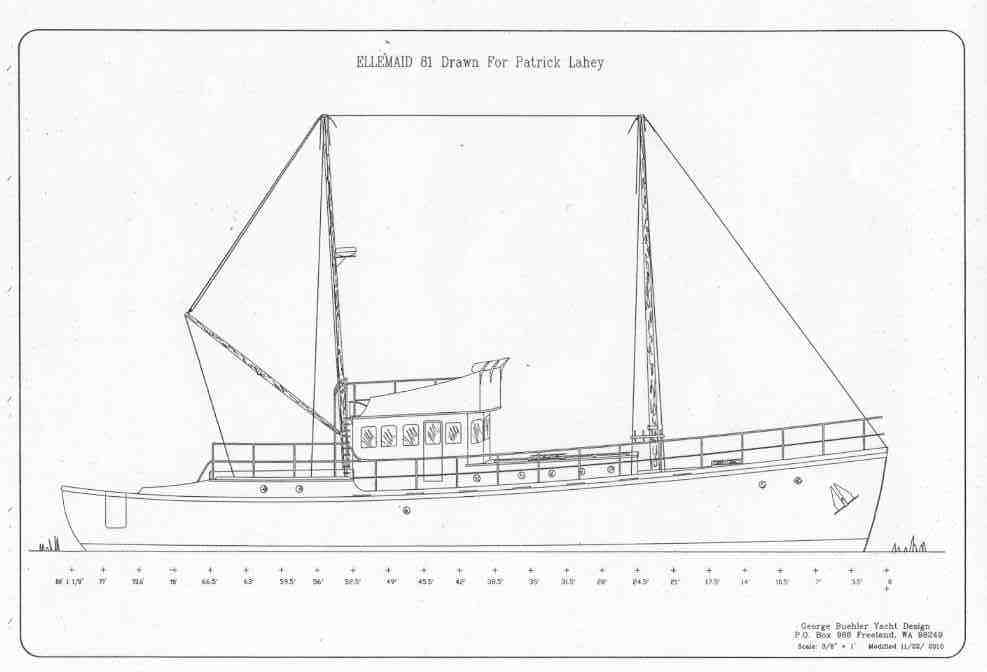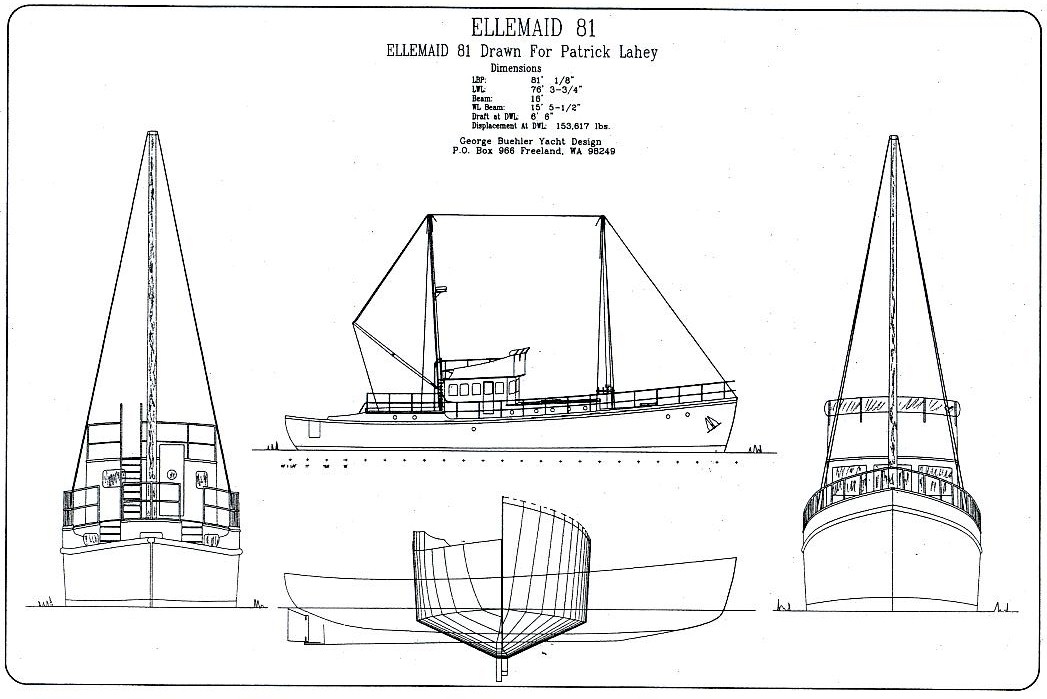I love this hull. She makes me think of those beautiful New England Sardine Carriers that go up and down the coasts of Maine and Nova Scotia pretty much regardless of the weather. They were every bit as able and attractive as the west coast trollers, you know, just longer. Forgive me running on, but to be a designer or builder of anything, be it a dress you sewed or a garden you dug or a bird house or of course a boat’s design, requires some ego because the motivation for most of us unfortunately certainly hasn’t proved to be money. So most of us who do things do it because it makes us feel good, and this hull, well, it turns me on. There’s nothing wrong with being egocentric about things you’ve done that you like. It’sonly boring to hear when YOU’RE boring about it, running on like it appears I’m starting to do now.
Anyway, I took WUNDERBURG‘s basic idea, stretched and deepened it a little, but whimped out a bit, turning it into a boat that would be more comfortable to use for full time live-aboard use. I added a big wheelhouse because when you get down to it, aside from the appeal of traveling in straight lines at a consistent speed, a big part of the cruising powerboat is the comfortable wheelhouse where a guy can sit at the helm, warm and dry, wearing slippers, and lean back and look out the windows as the heater keeps things 75 degrees and the windshield wipers flip back and forth. So unless I was going to base the boat exclusively in warm or at least mild climates, I’d most likely opt for this heavier duty version.
At 80′ feet you tend to think this is a big damn boat, but it isn’t. LENGTH isn’t what makes a big boat. Hull VOLUME is what makes a big boat. You can take “X” cubic feet and have it short, fat, and deep, or long, narrow, and shallow, and it’s still “X” cubic feet. The advantage to stretching it out is the hull is easier to build, the hull goes through the water easier, and you get a more spacious interior.The building and outfitting costs between the two will be almost identical because it’s still “X” volume. There will be more interior stuff though. The only down side I can think of is moorage. If you keep the boat in a normal marina the longer boat will cost more than the short boat. But if you’re building the boat for cruising than the moorage costs are far less important than it’s cruising qualities, because once you get away from North America the odds are that most of the time the boat will be anchored. The best comparison of the behavior between a boat like this and a “trawler” was told to me by my crab boat captain friend. He was plowing across the Bering Sea in a storm, the 110′ tank of a crab boat (think contemporary trawler yacht as many of them are essentially Alaskan crab boat type hulls)standing on its head and barely making headway. Way back on the horizon behind him was a speck. Pretty soon it turned into a boat.Soon after that along side and then passed one of the wonderful old Halibut schooners. The “schooners” are sort of SuperTrollers. They range from maybe 60′ to 80′ or so and have dimensions very much like this boat but deeper and heavier. Bill said it was rolling and pitching, but it was maintaining speed, and it left him in its wake.
So this is a very small boat. It’s D/L is only 154, but it’s long enough where it will be extremely comfortable. The interior drawing shows a lot of “white space,” but look close; it’s very comfortable. The private stern owner’s cabin is 17-1/2′ long. It has a 5′ x 7′, a full bathroom big enough to turn around in, a closet and dresser and lots of shelves, and an office sized desk. This big owner’s cabin makes a private place where you can get back by yourself. The desk is big enough to do real projects on without needing to pick up for meals or company. For instance, my wife is a hell of a seamstress. She could have her 1930’s Singer built into a desk like this, and there’d still be room on it for a computer and printer.
The wheelhouse sole is 10 1/2′. It has a big steering station, a lounge with table, a permanent chart desk with storage drawers, elbow room, and lots of big windows. Below it is a big engine room, and, a passageway to get to the aft cabin.
The forward cabin is very spacious, thanks in part to the flush deck design. It has a huge galley, a second bathroom, and a large guest cabin forward.
This guest cabin needs some discussion. Modern communications have opened up all sorts of new things you can do at home to earn a living. Just on the south end of the island we live on there’s5 AutoCad developers! God knows how many other program writers, freelance writers, “consultants,” and so on there are back in the trees. Fax machines and air and “e” mail have made it possible for people like this to live anywhere in the world and work.
My last boat was bought by a guy who used it for over 10 years as a traveling doctor’s office, going to isolated Alaskan communities. This boat’s forward cabin would be ideal for that, as well as a dentist’s office or especially an electronics repair shop. There’s a fortune to be made fixing and maintaining the systems that so many modern yachtsman put on their boats.You hear all the time about the numbers of broken down yachts in foreign places, and if you have the skills and equipment to work on them you could quite well.
She has a very simple and traditional profile. The primary difference between her and her 71′ cousin is the stern cockpit.
She’s rigged as a “pilot schooner.” This is a small rig but will be very easy to handle, will dampen roll, and will get you home in a pinch.
I like this interior but of course you’re free to set her up as you please. There’s 4 guest bunks in the bow and a guest double. That should be enough company!
Particulars
LOD: 81′ 1″ LWL: 76′ 4″ Beam: 16′ Draft at DWL: 6′ 6″ Displ.: 156,300 lb. Power: 175 Deere or equal.



